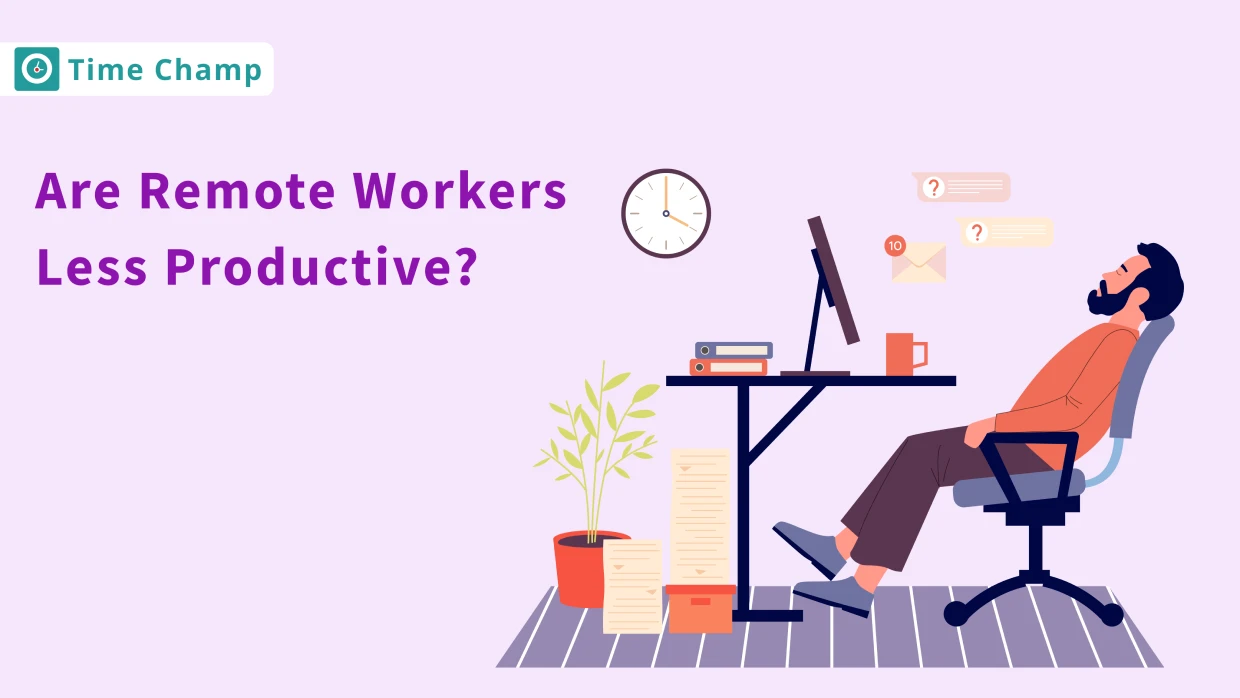Remote worker productivity is always a debatable topic, some say remote work increases productivity and some come up with statistical proofs like this “According to research by the Stanford Institute for Economic Policy Research, fully remote workers are almost 10% less productive than fully in-office workers.” to oppose this statement.
But are remote workers really less productive? Let’s find out.
Common Myths About Remote Work Productivity
We will debunk some common myths that people highly believe in about remote work.
Remote Workers are Less Distracted
That’s not actually true, many remote employees are fed up with remote work distractions like family members shouting, pets roaming around doing cute stuff, construction sounds, distracting neighbors, and the father of all distractions, the mobile phone.
In fact, a survey by the TSheets shows that 66% of the remote workers reported being distracted when working from home and 25% of them said they were distracted due to household chores.
Amid such distractions, it’s obvious that employees can’t focus on their work, and end up getting distracted.
Remote Employees can Be Just as Productive as Office Workers
As we already stated at the beginning of the blog studies show that remote workers are 10% less productive when compared to in-office workers. When this remote work trend started, employees showed much interest in it and worked productively, progressively this interest and productivity kept decreasing with time, making them feel lonely and demotivated to work from home because of a lack of socializing.
They are Always Available
Remote workers are expected to always be available, but they are actually not most of the time, and when you need them to join an important meeting, they might be on a break or having their lunch, because those breaks are not fixed for them, they have the flexibility to choose when.
In such cases communicating with the team members who are working remotely will become difficult.
Remote Teams Don’t Need Supervision to Stay Productive
This is the biggest myth, remote teams do need supervision just like your in-office workers, sometimes employees are well motivated to work by themselves and reach their targets, but situations won’t be in their favor all the time, there will be some days when they might feel less motivated, isolated, or even depressed at times.
With proper supervision, you can make sure your employees are always engaged and motivated to work .
Supervise your remote teams like a pro with Time Champ and ensure their productivity never dips
Sign Up for FreeBook DemoFactors That Influence Remote Work Productivity
While the debate over remote work environment continues, it’s important to recognize that several factors come into play beyond the simple choice of working from home or in an office. These factors, from your physical work environment to the technology you use, the support you receive from your organization, your personal time management skills, and your overall well-being, can significantly impact how productive remote workers truly are.
Let’s break down each of these elements in detail.
1. How Your Home Setup Impacts Your Day
Think about your workspace for a minute. Is it a quiet room with a dedicated desk, or is it a shared space where the TV, kitchen, or pets are always competing for your attention?
Now you know why remote employees are distracted often right?
A well-arranged, comfortable area can help your employees concentrate more and keep distractions away . On the flip side, a cluttered or noisy environment can pull your employees away from their tasks more often than they’d like. It all comes down to making their home just work for them and creating a zone that’s both inspiring and free from unnecessary interruptions.
2. The Role of Technology and Tools
Isn’t it irritating when you try to join an important video call and your internet drops to one bar and no need to talk about that crusty outdated software, on top of that you’ll get an earful from your manager. Sometimes remote workers have to face such situations, this is where reliable tech comes to help. Whether it’s a fast internet connection, the latest hardware, or user-friendly apps like Slack, Zoom, and Trello, having the right tools can streamline your day. When technology works smoothly, your employees are more likely to stay connected with the team and keep their workflows uninterrupted, which in turn boosts productivity.
3. The Support You Get from Your Organization
Remote work doesn’t mean working in isolation. A big part of staying productive comes from the feeling of being supported by the organization. Regular check-ins, clear goals, and a friendly team environment can make all the difference. When employees know they have strong support from their manager and colleagues, it fosters a sense of belonging and keeps them motivated. This kind of support helps bridge the gap between working remotely and staying in sync with the team’s overall objectives.
4. Managing Time and Staying Focused
Without any structure of an office, your employees are the captains of their own ships. The freedom it gives is great, but it also means they have to set some boundaries. Encourage them to explore time management techniques like the Pomodoro Technique, maintaining to-do lists, or blocking out dedicated periods on their calendars.
Emphasize that effective time management involves not only focusing on work but also knowing when to take breaks. By setting clear expectations and offering support, you can help your remote team avoid the pitfalls of procrastination and burnout, ensuring they remain productive and balanced.
5. Balancing Work and Life
One of the biggest perks of remote work is the promise of a better work-life balance . But let’s be honest, sometimes the line between “work time” and “home time” can get pretty blurry. You need to encourage your remote employees to set aside time for themselves, whether that means taking a walk, enjoying a hobby, or simply stepping away from their screens. When you make time to recharge, you not only feel better overall but also find that you can focus more effectively when it’s time to get back to work.
By supporting them to recharge, you not only help enhance their overall well-being but also boost their focus and productivity when they return to work. This approach ultimately leads to a more engaged and efficient workforce.
Unlock remote team productivity and happiness by creating a burnout-free, balanced workplace
Time Champ makes it effortless for your team to flourish
Sign Up for FreeBook DemoChallenges in Remote Work
No doubt remote work comes with many benefits, but there are two sides to a coin, here are some challenges remote work throws at organizations.
- Communication Gaps
- Loneliness and Isolation
- Monitoring Productivity
- Maintaining Employee Engagement
- Time Zone Differences
- Lack of Visibility into Employee Work
- Technology & Security Issues
- Work-Life Balance Struggles
- Onboarding New Remote Employees
- Cultural Differences
We have covered this topic in detail, if you want to know more about it then you can head here: Top 10 Challenges of Managing Remote Employees & Solutions
How Productivity Tracking Helps Ensure Remote Worker Productivity
You can ensure your remote employees stay productive when you have a proper productivity tracking tool like Time Champ with you.
Time Champ helps you track how productively your remote workforce is operating, what apps and websites they are using, and whether the apps are productive or not, and even shows you their work-life balance charts so that you can stay worry-free and ensure your employees are not burned out.
Here’s how Time Champ’s productivity tracking features help you create a highly productive and efficient workforce:
Apps and Website Usage
View which apps your employees use the most, and how much time they spend on each website, you can label these apps and websites as productive, non-productive, and neutral based on which these apps will be categorized.
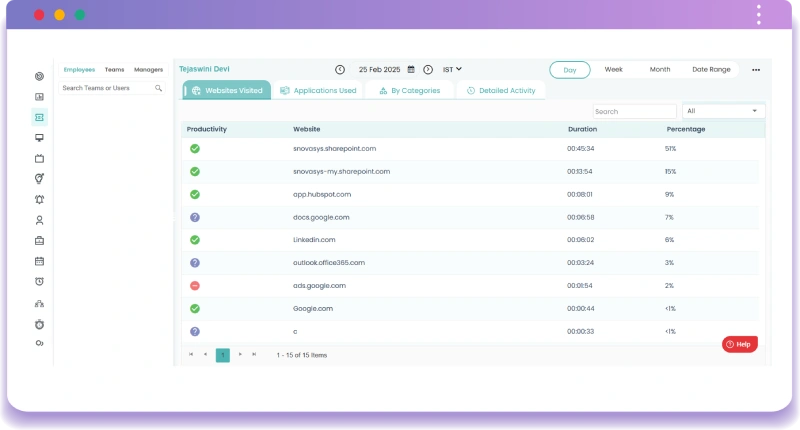
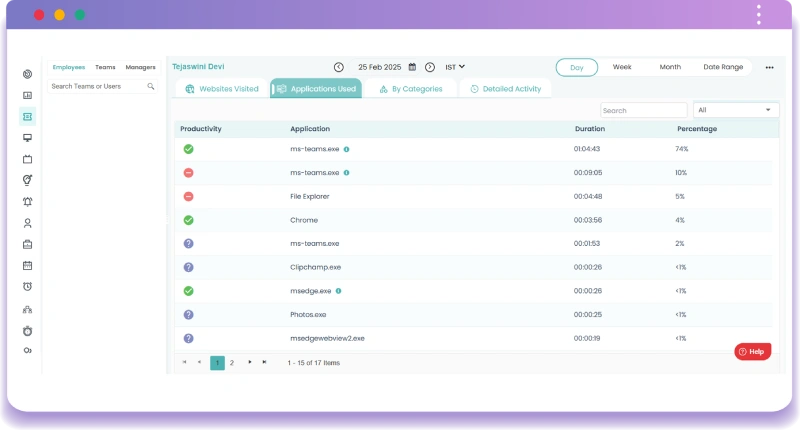
Productivity Tracking
Get productivity metrics based on tracked data like productive and non productive application used, productivity bar which shows how productive your employee is at a particular time, category breakdown percentages based on applications used.
You can view your employee’s overall weekly, monthly, or yearly productivity through this heatmaps feature, not just individual data but also you can view your whole team’s productivity data through the heat map representation at once to get an overall idea of how they are performing.
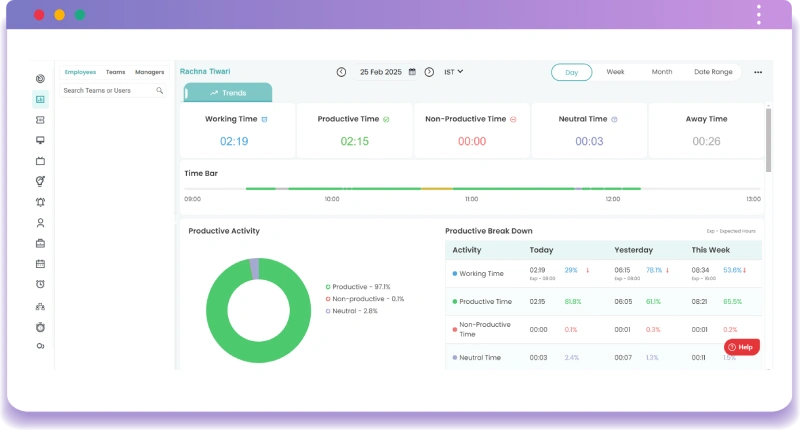
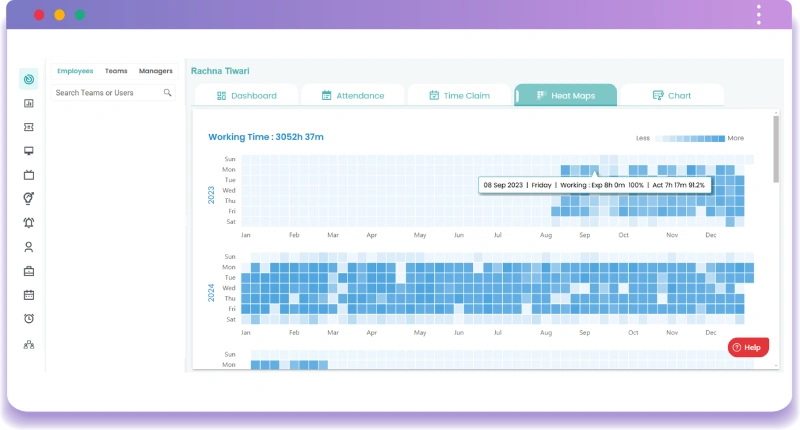
Activity Monitoring
See what your employees are working on in real-time, all from your system, there is no need to visit or connect with them to know about their task progress.
Track what they are doing during working hours and ensure they are not distracted.
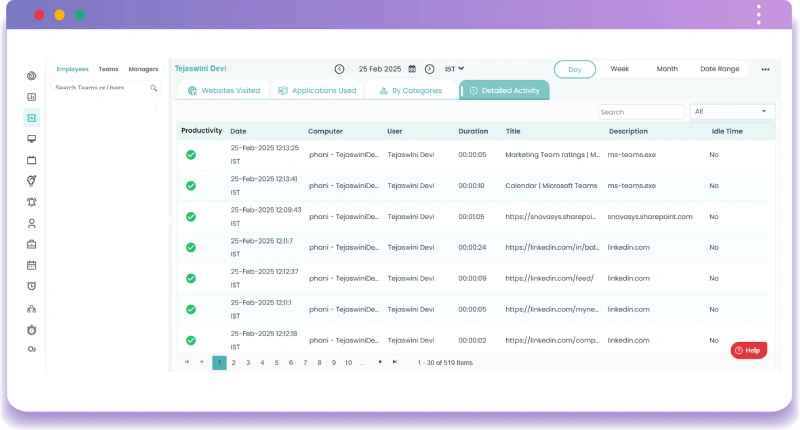
Screen Shots and Screen Recordings
Time Champ captures screenshots every 5 minutes (you can configure this screenshot capture frequency based on your needs) for proof of work and you can also watch screen recordings of your employee’s screens (only recorded during work hours, breaks excluded).
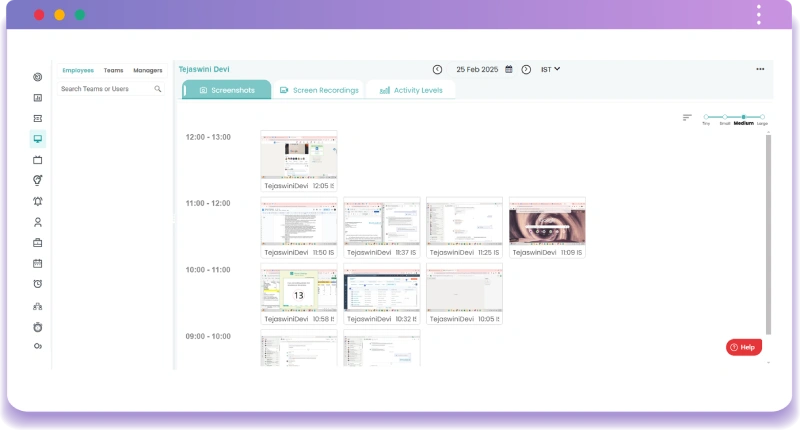
Attendance Tracking
You don’t need to worry about manually tracking your remote worker’s attendance anymore, Time Champ does it for you that too automatically and creates attendance reports based on the data traced (attendance is calculated based on log-in and log-out times, you can also set up leave rules like more than 3 late logins are considered as half-day leave).
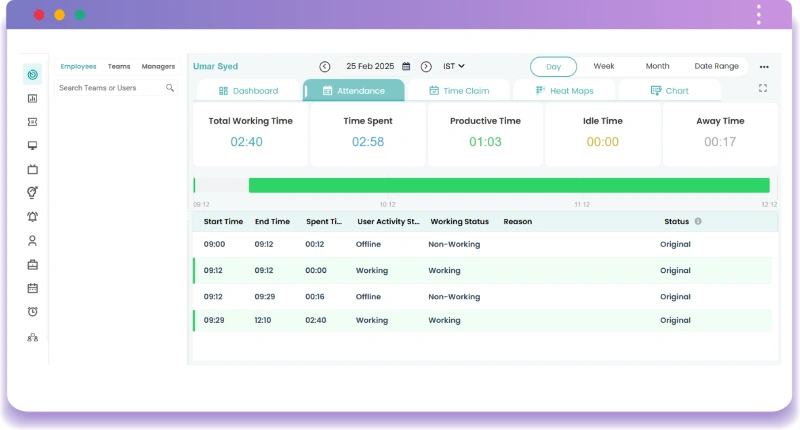
Live Location Tracking
Time Champ gives you full visibility of your employee’s location by tracking it in real-time, whether you have construction workers on-site, field agents traveling between locations, or remote teams working across different time zones.
Reports
Time Champ provides you with reports of every data tracked, which you can also download according to day, week, or even month.
Time Champ is your ultimate solution for comprehensive remote employee monitoring
Sign Up for FreeBook DemoConclusion
In conclusion, remote work productivity isn’t simply about being at home. Although studies show remote workers might be a bit less productive, a good workspace and reliable tools can make a big difference. Even with distractions at home, proper time management and support help keep work on track. With the right setup, remote work can be just as effective as office work.
You can also try implementing hybrid work models in your organization to create a healthy balance between remote and in-office work, ensuring that employees enjoy the flexibility of working from home while still benefiting from the collaboration and structure of a traditional office environment.
Frequently Asked Questions
Remote work can greatly improve employee satisfaction by giving team members more control over their time and reducing the stress of daily commutes. This flexibility supports an improved work-life balance. However, it’s essential for employers to maintain regular check-ins and open communication to keep employees engaged and motivated over time.
To strengthen remote work culture, you should establish clear company values and communicate them effectively to your remote team. Regular virtual team-building activities, like online coffee chats or collaborative workshops, help foster a sense of connection, even when everyone is working from different locations. This strengthens the overall feeling of unity and community within your team.
Effective remote collaboration begins with providing your team with the right communication tools, such as Slack, Zoom, or Trello. It’s important to set clear expectations, so everyone knows their role and responsibilities. In addition, regular virtual meetings ensure that you can catch up on projects and encourage brainstorming sessions that keep people engaged and invested.
Try hosting virtual coffee breaks, making time for online games, or holding collaborative workshops to build stronger relationships in your remote team. These activities encourage personal interactions, helping employees feel more connected, even when not physically together. Scheduling these social activities regularly can boost team morale and enhance the overall work environment.
To promote continuous learning, offer your team access to up-to-date training, webinars, or industry-specific courses. Encouraging employees to pursue personal development goals establishes a culture of growth. Regular feedback, along with built-in mentorship or coaching, helps employees continue to improve their skills and advance their careers, even while working remotely.
